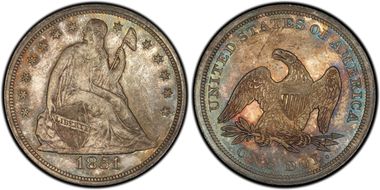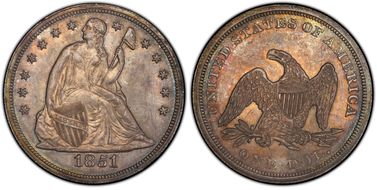1851 $1 MS62 认证号50183229, PCGS号6939
专家评论
Q. David Bowers
The following narrative, with minor editing, is from my "Silver Dollars & Trade Dollars of the United States: A Complete Encyclopedia" (Wolfeboro, NH: Bowers and Merena Galleries, Inc., 1993).Coinage Context
Record exports: In 1851 the excess of silver exports (including bullion, U.S. coins, and coins from other countries) over imports jumped to $23 million, up dramatically from just $2 million the year before according to Neil Carothers in Fractional Money (Carothers, Fractional Money, pp. 108-112, was the source of much of this information.) Coinage Laws of the United States reports an export figure of $6,635,839, much lower than Carother's figure but still showing a significant increase over the year before. (See Additional Information at the end of this 1851 section) In the years 1850 and 1851 the excess exports of silver were more than the entire face value of silver coinage for the preceding two decades. Much of this exportation was in the form of earlier-minted coins, including silver dollars, which tended to be of higher weight and better acceptability than foreign silver coins in domestic circulation. It is likely that large numbers of Liberty Seated dollars minted 1840- 1850 saw destruction in this manner. New silver coins were made in very small amounts in 1851, and none was put into circulation at the time. The relatively new gold dollar denomination helped fill the gap, and production soared to a record 3,658,820 pieces, over seven times the quantity minted the previous year.
Low silver dollar mintage: The Philadelphia Mint restricted its issuance of silver dollars this year and in the year following. Only a few silver dollars, 1,300 in all, were made in 185l. (It is unknown if these were coined for depositors or on government account. R.W. Julian, letter to the author March 10, 1992.) Carothers writes that none was placed into circulation at the time; otherwise, they would have been exported or melted. In the year 1851 gold dollars were produced at the Philadelphia Mint in the staggering and unprecedented quantity of 3,317,671 pieces, a number higher than the entire combined Liberty Seated silver dollar coinage from its inception in 1840 up to this point in time (1851). The Liberty Seated dollar had become a second-rate coin in American commerce, and from about this point onward little notice would be made of it.
What to do?: It became evident as the silver dollar became worth over $1.03 in meltdown value that the only way to have silver coins circulate was to select a ratio of silver unfavorable to gold. Another alternative was to make all silver coinage fiduciary-meaning that its face value would exceed its meltdown value. Congress had received proposals for such in 1800, 1816, 1819, 1832 and 1850. The subsidiary three-cent piece adopted in 1851 was doing quite well, yielding a profit, and demonstrating the value of fiduciary coinage. However, the members of the Congress Were not sufficiently versed in currency matters to understand the system. (Then, as has also been true in the 20th century, congressional testimony demonstrated vividly that the average elected official had very little knowledge of coinage, finance, and related matters. As modern-day readers of relevant articles in Coin World, Numismatic News, and other periodicals know well, trying to educate congressmen on tile fine points of coinage, designs, etc., is usually an exercise in futility.) Congress believed in general that silver was better as a standard than gold. Likewise, to a majority of Americans gold was still unfamiliar as a common medium. Only one country in the world (England) had adopted gold as its sole standard.
The eventual answer would be the Act of 1853, lowering the weights of all silver coins except the dollar and three-cent piece such in 1800, 1816, 1819, 1832 and 1850. The subsidiary three-cent piece adopted in 1851 was doing quite well, yielding a profit, and demonstrating the value of fiduciary coinage. However, the members of the Congress were not sufficiently versed in currency matters to understand the system. Congress believed in general that silver was better as a standard than gold. Likewise, to a majority of Americans gold was still unfamiliar as a common medium. Only one country in the world (England) had adopted gold as its sole standard. The eventual answer would be the Act of 1853, lowering the weights of all silver coins except the dollar and three-cent piece.
Numismatic Information
Circulated grades: Mint records indicate that 1,300 dollars bearing this date were minted. As noted, these were not placed into circulation at the time. Probably, they left the Mint in the year or two succeeding, in exchange for bullion deposits (this is speculation). The desirability of the low-mintage 1851 and 1852 dates was recognized early in the numismatic game, by which time most were no longer available at the source. By 1858, the "Midnight Minters" and others at the Mint knew full well that the 1851 (and 1852) dollars were rarities. It is logical to assume that by that time the original circulation strike mintages had been dispersed.
I believe that sharp-eyed bank tellers, Treasury employees, hotel clerks, and others, perhaps equipped with a coin buying guide issued by Cook, Morey, von Bergen, or some other nineteenth century precursor of B. Max Mehl, snapped up all the examples they could find. Such coin premium books were distributed in large quantities beginning with Cook's efforts in the mid-1870s and, for all I know, even earlier by others. Even so, very few were ever found.
The 1851 is a great rarity in circulated grades. Walter H. Breen suggests that most that do survive in worn grades are at higher levels such as grade EF or AU. (Letter to the author, February 12, 1992.)
Mint State grades: Most 1851 dollars known to exist are in Mint State. I suspect that the Mint saved a few at the time of issue, perhaps for trading purposes to acquire pieces for the Mint Cabinet.
Varieties
Circulation strikes:
1. High Date, frosty surfaces: Breen-5445. Obverse with date high in field, close to the rock base of Miss Liberty, and slanting down to the right. Shield point is approximately over left upright of 1. The base of the second 1 in the date is closer to the denticles than the first. Frosty (not prooflike) surfaces. Circulation strikes without prooflike surfaces typically have many parallel die striations in the fields. Reverse of Circulation strike No.1 of 1850 (also used to coin Proof No. 1 of 1850). Die cracks as described under 1850 Circulation strike No.1, but not as prominent (James C. Gray suggests that possibly the 1850 die was slightly lapped prior to striking the 1851 (Letter to the author, October 5, 1992.).
ANS specimen: Reverse crack at the rim below N of ONE, to base of 0 in same word. Crack from the rim at 8 o'clock to the upper left serif of U in UNITED.
2. High Date, prooflike surfaces: Breen-5445. Obverse as preceding, but now highly polished to remove clash marks. As noted, the existence of true Proofs is doubtful, and those attributed as such in the past are now believed to be prooflike circulation strikes. Reverse: As described earlier.
Dies prepared: Obverse: 1; Reverse: 1.
Circulation strike mintage: 1,300; Delivery figures by month: June or December (not certain, one or the other; existing Mint records are imperfect): 1,300.
Estimated quantity melted: Unknown
Characteristics of striking: Stars on the right obverse are usually flat; otherwise, the coins are average strikes. Frosty circulation strike coins have numerous die striae. Later strikings from highly polished dies have prooflike surfaces.
Known hoards of Mint State coins: None
Commentary
This is the rarest Philadelphia Mint silver dollar in the Liberty Seated series 1840-1873.
PCGS #
6939
设计师
Christian Gobrecht
边缘
Reeded
直径
38.10 毫米
重量
26.73 克
铸币数量
1300
金属成分
90% Silver, 10% Copper
更高评级数量
9
评级较低的钱币数量
17
地区
The United States of America
价格指南
PCGS 数量报告
拍卖 - PCGS 评级的
拍卖 - NGC 评级的
稀有性和存量估计 了解更多
| 所有评级 | 275 |
| 60或以上 | 35 |
| 65或以上 | 1 |
| 所有评级 | R-6.5 |
| 60或以上 | R-8.8 |
| 65或以上 | R-10.0 |
| 所有评级 | 1 / 30 |
| 60或以上 | 4 / 30 TIE |
| 65或以上 | 1 / 30 TIE |
| 所有评级 | 4 / 45 |
| 60或以上 | 10 / 45 TIE |
| 65或以上 | 1 / 45 TIE |























